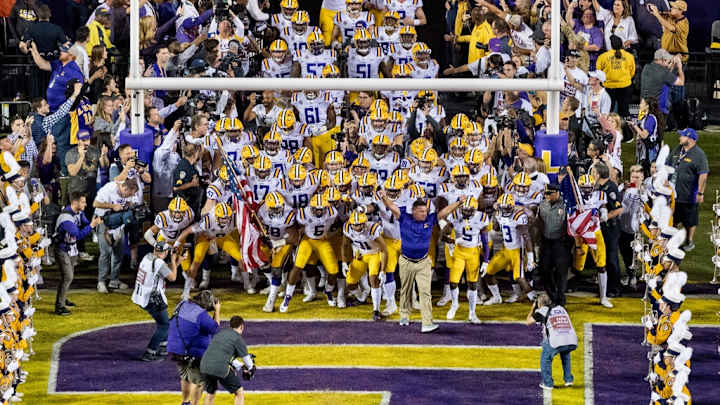Tiger Stadium to be at 25% Capacity for LSU Football Games This Fall

How many fans will Tiger Stadium hold in 2020? That’s the question that’s been on the minds of ticket holders hoping to catch LSU football in action this season.
On Friday that answer became clear as LSU stated in a press release that Tiger Stadium will be at 25% capacity this season. Interim president Tom Galligan said on Wednesday that he thinks that at 25% capacity, fans can be socially distanced. Additionally, tailgating will not be permitted in 2020 and fans who do attend games will be required to wear a face mask.
LSU’s capacity limit goes hand-in-hand with what other SEC stadiums will look like come Sept. 26. Jordan-Hare (Auburn) and Bryant-Denny (Alabama) will be at 20% capacity while Sanford (Georgia) will be at 20-25% capacity and Kyle Field (Texas A&M) will allow 25% capacity. Ben Hill Griffin stadium will be at 20% capacity, the school announced on Thursday. A total of 11 SEC teams have released stadium capacity plans at this point.
On gamedays, fans will enter the stadium in phases to eliminate big lines. The “Tiger Walk” down Victory Hill will also not be conducted and the band will be allowed in the stadium but will not be permitted to play on the field for pregame or halftime. Season ticket holders have until Sept. 11 to opt out of tickets for the 2020 season.
Announced SEC stadium capacities via the guys at @CBSSports:
— Ross Dellenger (@RossDellenger) August 20, 2020
Bama: 20%
Auburn: 20%
Arkansas: 23%
UGA: 20-25%
Miss. State: 25%
Ole Miss: 25%
Missouri: 25% or less
Tennessee: 25% or less
Texas A&M: 25%
“This plan focuses on the health and safety of all those attending LSU football games, from the fans to the team to the workers,” said Louisiana Gov. John Bel Edwards in a press release. “By reducing the capacity and taking a year off from tailgating, which puts LSU in line with other SEC schools, the plan allows for fans to be socially distanced in Death Valley. I encourage the Tiger faithful to adhere to these guidelines and to act responsibly, as there is still a lot of COVID in Louisiana. We will continue to monitor our case counts, test positivity rate and hospitalizations and make adjustments as necessary. While this season is undoubtedly starting out differently from a normal football season, with COVID keeping all of us from celebrating together, nothing can dim the support we have for our LSU Tigers.”
LSU athletic director Scott Woodward said on 104.5 ESPN that the guidelines could change one way or the other and that the athletic department will look at how restaurants and businesses approach increased capacities. That means there could be an increase or a decrease in fan attendance based on data they receive throughout the season.
Tailgating is another question that many fans have questions about. The SEC says any tailgating will be left up to each institution and LSU interim president Tom Galligan said in a recent radio interview with WRKF that the university would likely discourage people who don't have tickets from going to campus.
"If we can have fans, we’re probably going to urge a lot of the people who don’t have tickets to the game to not come to campus," Galligan said.
Bel Edwards and LSU’s decision on tailgating runs in conjunction with what other states have decided. Mississippi governor Tate Reeves announced on Aug. 20 that there would be no tailgating of any kind allowed in the state.
The SEC has already released gameday health protocols which will require all fans in attendance to wear masks. For a full list of gameday requirements for both fans and stadium staff members, click here.
A limited crowd in Tiger Stadium is something that LSU has and will prepare for over the next few weeks during its preseason scrimmages. The Tigers held their first scrimmage on Friday and coach Ed Orgeron said the team will have to create its own energy with a reduced crowd.
"Here's what to expect. This week, we start preseason game No. 1 so we're going into Tiger Stadium for the first time. We have not been into Tiger Stadium yet,” Orgeron said Sept. 1.
"It's going to be a good time for me to talk about, 'Hey, we have to create our own energy. We have to create our own excitement.' It may not be what we expect, but the other team is there, they're here to win. Everybody's playing on an equal playing field so it's going to be something new. I think if you pipe in noise for away games, but that's expecting a big crowd. When you pipe in noise, the players don't have to make the energy and I think that's a mistake. I think that we have to learn how to make our own energy, how to create our own noise. We have to do that on the sideline."
